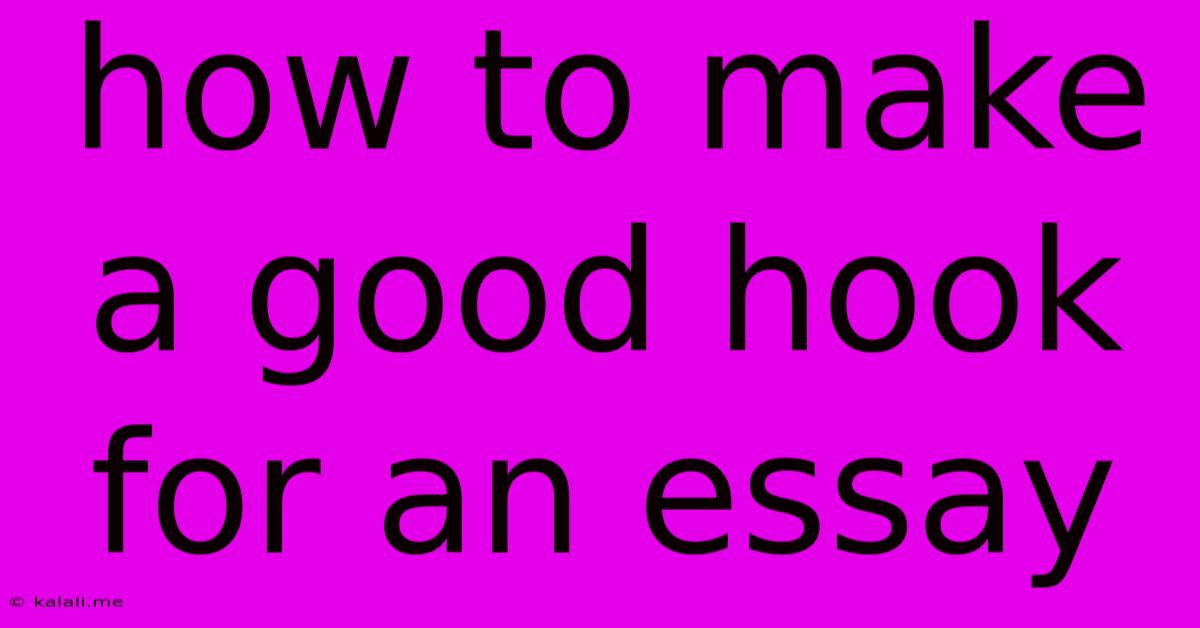How To Make A Good Hook For An Essay
Kalali
Jun 08, 2025 · 3 min read

Table of Contents
How to Craft a Killer Hook for Your Essay: Grab Your Reader's Attention from the Start
Meta Description: Learn how to write compelling essay hooks that instantly engage your readers. This guide covers various techniques, from startling statistics to intriguing anecdotes, to help you master the art of the essay hook and boost your essay's impact.
Starting an essay can be daunting. You've got a brilliant argument, compelling evidence, and a well-structured outline, but without a captivating hook, your masterpiece might gather dust unread. A strong hook is your essay's first impression – your chance to grab the reader's attention and compel them to journey through your words. This guide explores various techniques to craft a hook that leaves a lasting impression.
Understanding the Purpose of an Essay Hook
Before diving into specific techniques, it's vital to understand the purpose of a hook. It's not just about grabbing attention; it's about establishing a connection with your reader and setting the tone for your essay. A good hook should:
- Spark Curiosity: Tease the reader with a question, a surprising fact, or a hint of what's to come.
- Establish Context: Briefly introduce the topic and its relevance.
- Set the Tone: Convey the overall mood and style of your essay (formal, informal, humorous, serious, etc.).
- Create a Smooth Transition: Lead naturally into your thesis statement and the body of your essay.
Proven Techniques for Crafting Effective Essay Hooks
Now, let's delve into the practical strategies you can employ:
1. The Startling Statistic or Fact: Begin with a shocking statistic or an intriguing fact related to your topic. This instantly piques the reader's curiosity and sets the stage for a compelling argument. For example, if you're writing about climate change, you could start with: "Every year, millions of tons of carbon dioxide are released into the atmosphere, accelerating global warming at an alarming rate."
2. The Anecdote or Personal Story: A captivating personal story or a brief anecdote related to your topic can create an immediate connection with the reader. This approach humanizes your essay and makes it more relatable. For example, if discussing the importance of education, you could share a brief personal experience that highlights its transformative power.
3. The Provocative Question: Pose a thought-provoking question that directly relates to your essay's central theme. This forces the reader to engage with your topic on an intellectual level. For instance, "Is artificial intelligence a blessing or a curse for humanity?" compels the reader to consider the implications.
4. The Bold Statement or Controversial Opinion: Open with a strong, declarative statement that immediately grabs attention. However, ensure it’s supported by evidence in the essay to avoid seeming unsubstantiated. A statement like, "Social media is destroying genuine human connection," immediately sparks debate.
5. The Vivid Description or Imagery: Paint a picture with your words. Use sensory details to create a vivid scene that draws the reader into your essay's world. This works particularly well for essays on creative topics or those that explore emotional experiences.
6. The Quotation: Begin with a relevant and impactful quote from a well-known figure or literary work. This immediately provides context and credibility. Choose a quote that resonates with your topic and adds depth to your introduction.
Avoiding Common Mistakes
- Being too vague or general: Your hook needs to be specific and directly related to your essay topic.
- Overusing clichés or predictable phrases: Avoid common opening lines that lack originality and fail to grab attention.
- Making it too long or convoluted: Keep your hook concise and to the point; it's an introduction, not the entire essay.
- Failing to connect it to the thesis: Your hook should smoothly lead into your thesis statement and the main body of your essay.
By mastering the art of the essay hook, you can transform your writing from mundane to mesmerizing. Experiment with different techniques, find your unique voice, and watch your reader engagement soar!
Latest Posts
Latest Posts
-
Signs And Symptoms Of A Blown Head Gasket
Jun 09, 2025
-
How To Get Rid Of Sulphur Smell In Toilet
Jun 09, 2025
-
How Many Ounces In Bottle Of Beer
Jun 09, 2025
-
How Do I Remove Window Screens
Jun 09, 2025
-
Did Socrates Believe In Greek Gods
Jun 09, 2025
Related Post
Thank you for visiting our website which covers about How To Make A Good Hook For An Essay . We hope the information provided has been useful to you. Feel free to contact us if you have any questions or need further assistance. See you next time and don't miss to bookmark.